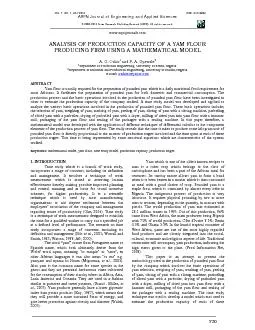/


VOL 7 NO 7 JULY 2012 ISSN 1819660 ID: 143844
Download Pdf The PPT/PDF document "ABSTRACT Yam flour is usually required f..." is the property of its rightful owner. Permission is granted to download and print the materials on this web site for personal, non-commercial use only, and to display it on your personal computer provided you do not modify the materials and that you retain all copyright notices contained in the materials. By downloading content from our website, you accept the terms of this agreement.
ABSTRACT Yam flour is usually required for the preparation of pounded yam which is a daily nutritional food requirement for most Africans. It facilitates the preparation of pounded yam for both domestic and commercial consumption. The production process and the basic operations involved in the production of pounded yam flour have been investigated in other to estimate the production capacity of the company studied. A time study model was developed and applied to analyze the various basic operations involved in the production of pounded yam flour. These basic operations include; VOL. 7, NO. 7, JULY 2012 ISSN 1819-6608 ARPN Journal of Engineering and Applied Sciences ©2006-2012 Asian Research Publishing Network (ARPN). All rights reserved. www.arpnjournals.com = x f (y) (4) but = nt t x f (ya (5) It is assumed that the rate at which machines are producing and the working rate of workers is constant. Thus Equation (5) becomes: 11ti f + ntWe generalize the model by taking f (y) as f(y), 1im as: and as Thus t = 1m w1 f ydy+ nta (6) Assuming that the total number of products produced is denoted by symbol (X), while T is the total time spent for all the products, Equation (6) above becomes, = X( 1m w1 f ydy+ nt) (7) Equation (7) is the general formula for the total time spent in producing x products. 3.1 Raw materials and electricity supply Consider the issue of unavailability of raw materials which are the fresh palm fruit bunches and irregular electricity supply and assuming that f(y) is a function of these two parameters of indices such that we have f(y) and f(y, z). Therefore Equation 7 can now be expressed as follows: T = Xt = X( 1m (,) f yzdydz) (8) This equation gives the real general formula for the total time spent in producing y products. 4. APPLICATION OF THE TIME STUDY MODEL AND DISCUSSION This study which is a case study of a pounded yam flour processing company is a real life situation of a production company in Edo state of Nigeria. The company specializes in the production of pounded yam flour with 18 workers. It has different types of machines and other facilities for its production. The company operates a nine hours daily production cycle. However, during festive periods such as Christmas, a large number of customers usually patronize the companys products resulting in huge spike sales. This sometimes, usually leads to increase in the daily working hours of the workers. This general formula for the total time spent in producing y products is given in the equation below (Oke, 2006). T = Xt = X( 1m w 1 f ydy) (9) where T is the total time spent for all the products, X = number of products produced n = number of workstations and t= the time allowance Assuming that the electricity supply index (y) obeys a linear function such as 2y + 5, then the expression is now f(y) = 2y + 5. From the above equations, we know that (n) is the number of workstations while (t) is the time allowance. From the actual production observation, the mathematical model that fit the time problem in terms of number of machines is: t = my + m + y (10) Differentiating Equation (10) gives: + 2my Also, the mathematical expression that represents time with respect to the number of workers is: t = wy + y (12) Differentiating above gives: = y + 2wy. (13) Note that (n) has been stated earlier as the number of workstations, and (t) is the time allowance. If 87 gm of yam flour are produced by the company for 0.056 second per unit product, then we have allowance. VOL. 7, NO. 7, JULY 2012 ISSN 1819-6608 ARPN Journal of Engineering and Applied Sciences ©2006-2012 Asian Research Publishing Network (ARPN). All rights reserved. www.arpnjournals.com 824 production process of yam flour in other to analyze the various production activities of the company. REFERENCES Aft L.S. 2000. Work Measurement and Methods Improvement. John Wiley and Sons. ISBN: 0471370894. Brand-Miller J., Burani J. and Foster-Powell K. 2003. The New Glucose Revolution - Pocket Guide to the Top 100 Low GI Foods. ISBN 1-56924-500-2. Edo M., Evans T.D. and Viengkham O.V. 2001. Study on Structure and Time of Assembly Motion from a Viewpoint of the Motion Velocity. Bulletin of the College of Engineering, Forest Ecology and Management. New York, USA. Food Information Network. 2008. Wageningen University, the Netherlands. Kay D.E. 1987. Root Crops. Tropical Development and Research Institute: London. Mignouna H.D., Abang M.M. and Asiedu R. 2003. Harnessing Modern Biotechnology for Tropical Tuber Crop Improvement: Yam (Dioscorea spp.) Molecular Breeding. Oke S.A. 2006. A Case Study Application of Time Study Model in an Aluminum Company. Pacific Journal of Science and Technology. 7(2): 153-162. Walsh S. 2003. Plant Based Nutrition and Health. ISBN 0-907337-26-0. New York, USA. p. 47. Watson I.J. 1988. Electronic Time Study. Colliery Guardian. 236(5): 144. Worrall B.M. and Smith M.D. 1985. Application of Computerized Time Study to Establish Time Standards. Springer-Verlag: Berlin. pp. 745-750.